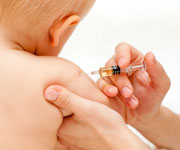AUSTRALIAN experts have cautiously welcomed a US study showing a potential protective link between some common childhood vaccinations and childhood cancers.
However, the experts and the study authors agree more research is needed before the link can be confirmed.
The case–control study, published in the Journal of Pediatrics, examined the association between childhood cancers, specifically acute lymphoblastic leukaemia (ALL), medulloblastoma and non-Hodgkin lymphoma, and vaccination rates in Texas.(1)
The authors said their study findings indicated that immunisation programs may not only reduce the number of infectious diseases in childhood but also contribute to some immunologic defence against the development of certain cancers.
The Texas Cancer Registry identified 2800 cancer cases from 1995 to 2006 diagnosed at ages 2–17 years. State birth certificate data were used to identify 11 200 matched control subjects.
Vaccination rates among cases and controls were compared at the county and public health region level.
The study found that children born in counties with higher hepatitis B vaccine coverage had lower odds of all cancers combined (OR, 0.81) and ALL specifically (OR, 0.63).
There were also decreased odds for ALL with higher rates of uptake of the inactivated poliovirus vaccine (OR, 0.67) and the “4-3-1-3-3” vaccination series — which includes four doses of the diphtheria, tetanus and acellular pertussis (DTP) vaccine, three doses of the inactivated polio virus, one dose of the measles, mumps and rubella (MMR) vaccine, three doses of the Haemophilus influenzae type b (Hib) vaccine, and three doses of the hepatitis B vaccine (OR, 0.62).
However, in contrast, children born in counties with MMR vaccine rates at or above the 90th percentile had higher odds of non-Hodgkin lymphoma (OR, 2.81).
“Although the biologic mechanism behind the effect of vaccinations on childhood cancer remains to be determined, our results corroborate findings from previous studies that point to a reduced risk from common vaccines against the development of ALL,” the authors said.
They said the findings had to be verified in larger studies with individual vaccination histories.
Dr Lesley Ashton, head of the molecular epidemiology group at the Children’s Cancer Institute Australia, based at the University of NSW, said the methodological approach used by the investigators in the paper had some limitations and needed to be confirmed in a larger study.
However, although there was no direct evidence of the biological mechanism behind the relationship between vaccinations and reduced risk of developing childhood leukaemia, epidemiological studies had shown a decreased risk of leukaemia associated with vaccinations for measles, DTP, Hib and BCG for tuberculosis.
Dr Ashton said that her group was conducting a national case–control study examining the causes of childhood ALL in Australia.
“Unlike the study conducted in Texas, our Australian study had access to the vaccination records of individual children,” Dr Ashton said. “Hence, we will be looking closely at the timing, dose and type of vaccinations at an individual level.”
Professor Catherine Cole, paediatric haematologist and oncologist at Princess Margaret Hospital for Children in Perth, said the study was interesting but there were lots of confounders that needed to be accounted for in such studies before an independent protective association between vaccination and childhood cancer could be confirmed.
“It is difficult to say if the effect is from vaccination, or being in a higher social class more likely to vaccinate, or another factor, for example, higher use of periconceptual folate which is shown in some studies to be associated with a lower incidence of ALL,” she said.
Professor Robert Booy, head of the clinical research team at the National Centre for Immunisation Research and Surveillance, said the research seemed very preliminary and needed confirmation.
“I strongly suspect the likelihood of confounding,” he said. “We know that cancers have got a socioeconomic link and it may be that it could be confounding this apparent association.”
However, the study authors said that by using a large pool of population-based control subjects, the distribution of potential risk factors between the cases and control subjects was similar and reduced the possibility that the results were due to confounding.
– Cathy Saunders
1. J Pediatr 2011; doi:10.1016/j.jpeds.2010.11.054.
Posted 24 January 2011

 more_vert
more_vert